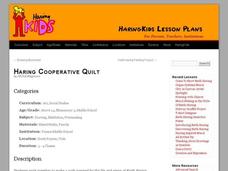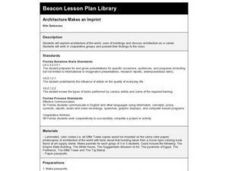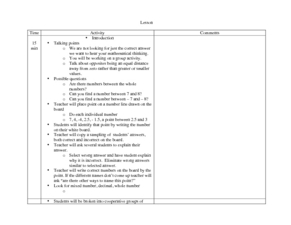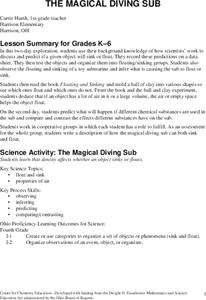Curated OER
Haring Cooperative Quilt
Students inspect visual arts by examining images on the web. For this art history lesson, students discuss the history of art after researching Keith Haring's work on the Internet. Students analyze the style of...
Curated OER
What's for Dinner? (Using Adjectives)
Sixth graders use adjectives to describe foods listed in restaurant menus. In cooperative groups, 6th graders create menus and identify the adjectives used in the menu created by their group.
Curated OER
Native Americans of the USA
Students, in cooperative groups, research a variety of Native American tribes on the Internet and complete corresponding activities. They participate in a play about Native Americans by Sandra Widener.
Curated OER
A Book a Day Will Keep the Teacher Away
Students work in cooperative groups to read a book in a day. Each group is assigned a portion of the book to read and uses the jigsaw learning strategy to review the book as a whole class.
Curated OER
Farm Animals: blind folded
Learners yell out their farm animal noise while being blind folded and have to find their animal group. In this group activity lesson plan, students learn how to work together to achieve a common goal.
Curated OER
Love and Friendship
Third graders do a hands-on activity after being read aloud the story of The Rag Coat, in cooperative groups.
Curated OER
Bats, Bats, Everywhere!
Students research information on bats while working in cooperative groups. They design posters with the information from their research.
Curated OER
The 3R's: Rights, Rules, and Responsibilities
Eighth graders complete seven work stations that highlight math activities while they focus on the rules for Internet use and classroom rules for working in cooperative groups. After completing the activities, they complete a self-...
Curated OER
Author's Purpose
Students discuss and define what folk and fairy tales are. In this literature lesson, students construct their own working definitions for folk and fairy tales. Students choose to work as a class or in cooperative groups. Then students...
Curated OER
Explaining the Bill of Rights
Learners define the terms Bill of Rights and amendment. They successfully explain the meaning of each amendment of the Bill of Rights. Students work together in cooperative groups.
Curated OER
Wild Animal Investigation - Habitat Diorama
Students research wild animals in cooperative groups and use their information to construct habitat dioramas. They demonstrate competence in using different information sources, including those of a technical nature, to accomplish...
Curated OER
Your Place in Time Scavenger Hunt
Fifth graders divide themselves into groups of 3 or 4, research 4 different generations, and answer the questions on the handout provided. They then work in cooperative groups to create a poster illustrating their generation.
Southern Nevada Regional Professional Development Program
“Double Double Speak Speak”
Bilateral suborbital hematoma? Call an audible? 404? Have fun with “the twittering or warbling of birds,” or as 14th century French speakers would say, have fun with “jargon.” Groups match specialized jargon with plain speech, decode...
Curated OER
Questions About Rivers
Students investigate rivers. In this geography lesson, students work in cooperative groups to read about rivers from articles they have collected. Students form questions using Bloom's Taxonomy as a guide.
Curated OER
Architecture Makes An Imprint
Fifth graders explore architecture of the world, uses of buildings and discuss architecture as a career. They work in cooperative groups and present their findings to the class. This instructional activity can be expanded to include a...
Curated OER
Create a Word
Brainstorm new words for a class dictionary. In small groups, young learners read and discuss an article about how words get into dictionaries. They then develop a new word, use it in a sentence, and share their creations with their...
Curated OER
Using a Number Line: 5th Grade Math
Working in groups, the class will use what they know about whole number operations to solve a real-world problem involving a number line. They will focus on using the number line to correctly label the placement of whole numbers,...
Curated OER
How Will You Measure Up?
Third graders use the appropriate units of measure when given a list of items to estimate and measure. They work in cooperative groups to locate, estimate, and measure given items using the correct unit of measurement.
Curated OER
Landmark Restoration Project-Scale Model Measurements
Learners work in cooperative groups to find the actual measurements of an historical building/landmark. Then they use ratio and proportion to figure the measurements that might be used to create a scale model of the structure.
Curated OER
Equal Differences Over Equal Intervals 1
Learners explore linear functions concretely using tables of values in a cooperative task. The concept of the values of linear functions changing by equal differences over equal intervals of one is emphasized. Learners will discover...
American Society for Microbiology
”Build a Bacterium” Scavenger Hunt
An exciting activity has scholars use cell parts to build bacteria through cooperation with other groups. Each group has some of the cell parts needed, but they must trade with other groups to be able to fulfill their function as a...
Curated OER
The Magical Diving Sub
First graders discuss and predict if a given object sinks or floats. They record their predictions on a data sheet. Pupils test the objects and organize them into floating/sinking groups. Students observe the floating and sinking of a...
Curated OER
Green Stuff: Designing an Earth-Friendly Room
In this activity students explore earth-friendly materials that can be used in home environments. They learn about the relationship between the environment and design, and use a variety of problem-solving strategies. They work in...
Curated OER
All About Me Books
Young authors write books about themselves using one of the identified types of literature and the writing process. They identify the common characteristics among the books in each group, edit, and gift their books to a younger student.

























